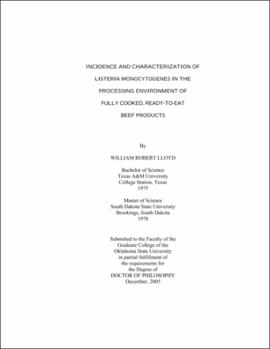| dc.contributor.advisor | Morgan, J. Brad | |
| dc.contributor.author | Lloyd, William Robert | |
| dc.date.accessioned | 2013-11-26T08:31:29Z | |
| dc.date.available | 2013-11-26T08:31:29Z | |
| dc.date.issued | 2005-12 | |
| dc.identifier.uri | https://hdl.handle.net/11244/7150 | |
| dc.description.abstract | Scope and method of Study: Commercial ready-to-eat (RTE) facilities (five in Phase I, three in Phase II) were divided into four zones based on the contamination risk to the RTE product being produced. These zones include: Zone 1 (final slicing/packaging of RTE products); Zone 2 (common areas including hallways and cooling areas); Zone 3 (raw material receiving and storage); and Zone 4 (cafeteria and dry storage). Test facilities produced a variety product types (i.e. hot dogs, roast beef, sliced luncheon meats, pepperoni, tacos, taco meat, pastrami and pizza toppings). In this investigation, environmental samples (Phase I, n = 6,030; Phase II, n = 3,000) were collected from pre-selected, non-product contact sites in RTE facilities located in diverse geographical regions of the U.S. Raw material meat samples and air samples were collected and evaluated for L. monocytogenes in Phase II. An outside laboratory performed Listeria analysis and ribotyping. | |
| dc.description.abstract | Findings and Conclusions: Using information gathered during this project to develop corrective actions, there was a 50% overall reduction in L. monocytogenes positive samples from Phase I to Phase II. There were 19 and 17 different ribotypes identified in the isolates from Phase I and Phase II, respectively. The predominant ribotypes in this study were DUP-1039, DUP-1052, DUP-1059 and DUP-1062. Thirteen different ribotypes were identified from the 80 raw meat isolates evaluated, with DUP-1039 and DUP-1052 comprising 45% and 21% of the isolates, respectively. Listeria monocytogenes was not recovered from any of the air samples collected. In general, based on these data, the industry needs to continue to focus on floors, drains and traffic patterns in order to maintain control of Listeria and reduce the potential for cross contamination. L. spp. control must be implemented, monitored and maintained in adjoining areas to the RTE area in order to maintain adequate control in the processing facility. | |
| dc.format | application/pdf | |
| dc.language | en_US | |
| dc.rights | Copyright is held by the author who has granted the Oklahoma State University Library the non-exclusive right to share this material in its institutional repository. Contact Digital Library Services at lib-dls@okstate.edu or 405-744-9161 for the permission policy on the use, reproduction or distribution of this material. | |
| dc.title | Incidence and characterization of Listeria monocytogenes in the processing environment of fully cooked, ready-to-eat beef products | |
| dc.contributor.committeeMember | DeWitt, Christina A. Mireles | |
| dc.contributor.committeeMember | Escoubas, J. Roy | |
| dc.contributor.committeeMember | Case, Kenneth | |
| osu.filename | Lloyd_okstate_0664D_1659.pdf | |
| osu.accesstype | Open Access | |
| dc.type.genre | Dissertation | |
| dc.type.material | Text | |
| thesis.degree.discipline | Food Science | |
| thesis.degree.grantor | Oklahoma State University | |
